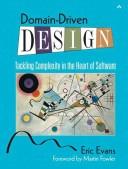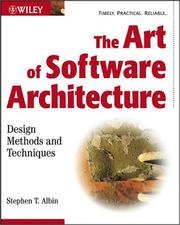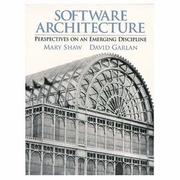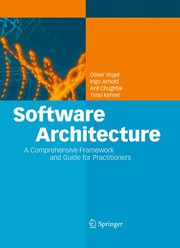Are you a software architect looking to expand your knowledge and skills? Look no further! We’ve compiled a list of the 20 best books about software architecture that are guaranteed to take your expertise to the next level. Whether you’re a beginner or a seasoned professional, these books cover a wide range of topics, from design principles and patterns to system scalability and security. So, if you’re ready to dive deep into the world of software architecture, pick up a book on software architecture from our list and get ready to elevate your game!
Contents
- 1 20 Best Software Architecture Books
- 2 Clean Architecture: A Craftsman’s Guide to Software Structure and Design
- 3 Software Architecture in Practice
- 4 Designing Data-Intensive Applications
- 5 Domain-Driven Design: Tackling Complexity in the Heart of Software
- 6 Building Microservices: Designing Fine-Grained Systems
- 7 Software Systems Architecture: Working with Stakeholders Using Viewpoints and Perspectives
- 8 Patterns of Enterprise Application Architecture
- 9 The Pragmatic Programmer: Your Journey to Mastery
- 10 Release It!: Design and Deploy Production-Ready Software
- 11 Software Architecture: Foundations, Theory, and Practice
- 12 97 Things Every Software Architect Should Know
- 13 Enterprise Integration Patterns: Designing, Building, and Deploying Messaging Solutions
- 14 The Art of Software Architecture: Design Methods and Techniques
- 15 Software Architecture: Perspectives on an Emerging Discipline
- 16 Just Enough Software Architecture: A Risk-Driven Approach
- 17 Software Architecture: A Comprehensive Framework and Guide for Practitioners
- 18 Building Microservices
- 19 Software Systems Architecture: Working with Stakeholders Using Viewpoints and Perspectives
- 20 Software Architecture for Developers
- 21 Software Architecture in Action
- 22 Final Thoughts on Best Software Architecture Books
- 23
20 Best Software Architecture Books
Clean Architecture: A Craftsman’s Guide to Software Structure and Design
by Robert C. Martin
Clean Architecture: A Craftsman’s Guide to Software Structure and Design is a renowned book on software architecture written by Robert C. Martin. This book about software architecture provides an in-depth exploration of the principles and practices behind building maintainable and scalable software systems. Martin, a well-respected figure in the software development community, presents a comprehensive guide to designing software with a focus on separation of concerns, testability, and maintainability.
Readers will gain valuable insights into the importance of clean architecture and its impact on the success of software projects. Martin emphasizes the need for developers to prioritize the architecture of their systems, highlighting the significance of clean code and modular design. This software architecture book is a must-read for software engineers, architects, and anyone involved in the development of complex software applications. Whether you are a seasoned professional or a novice in the field, Clean Architecture offers practical advice and timeless principles for creating software systems that stand the test of time.
Software Architecture in Practice
by Len Bass, Paul Clements, Rick Kazman
Software Architecture in Practice by Len Bass, Paul Clements, and Rick Kazman is a comprehensive and practical guide for anyone looking to gain a deep understanding of the principles and best practices of designing and implementing software systems. This renowned book on software architecture provides invaluable insights into the complexities of building and maintaining large-scale software systems, offering real-world examples and case studies to illustrate key concepts.
Through a combination of theory and hands-on guidance, the authors delve into the essential elements of software architecture, including architectural styles, design patterns, and quality attributes. They also explore the importance of architectural decisions in driving the success of a software project, emphasizing the need for clear communication and collaboration among stakeholders.
Whether you’re a seasoned software architect or a newcomer to the field, this book about software architecture is a must-read, offering practical advice and actionable strategies for creating robust and scalable software solutions. With its clear and engaging writing style, Software Architecture in Practice is an indispensable resource for anyone seeking to master the art of software architecture.
Designing Data-Intensive Applications
by Martin Kleppmann
Designing Data-Intensive Applications by Martin Kleppmann is a comprehensive book on software architecture that delves deep into the world of data systems and the challenges that come with building and maintaining them. Kleppmann takes readers on a journey through the fundamental principles of data-intensive applications, exploring topics such as data modeling, storage and retrieval, and data processing. The book also covers the various technologies and techniques used in building robust and scalable data systems, including relational databases, distributed systems, and stream processing.
With a clear and engaging writing style, Kleppmann presents complex concepts in a digestible manner, making this book about software architecture suitable for both experienced practitioners and newcomers to the field. Through real-world examples and case studies, readers gain a deep understanding of the trade-offs and design decisions involved in creating data-intensive applications. Whether you’re a software engineer, data scientist, or technical architect, this software architecture book is a valuable resource for mastering the intricacies of building resilient and efficient data systems.
Domain-Driven Design: Tackling Complexity in the Heart of Software
by Eric Evans
Domain-Driven Design, written by Eric Evans, is a groundbreaking book on software architecture that tackles the complexity at the core of software development. Evans introduces the concept of domain-driven design, which focuses on creating a deep understanding of the problem domain within the software development process. The book emphasizes the importance of collaboration between technical and domain experts, as well as the significance of clear communication and shared understanding within a development team.
Evans presents practical techniques and strategies for building complex software systems that align with the domain and business needs. He discusses various patterns and approaches for designing software that reflects real-world domains, ultimately leading to more maintainable, scalable, and adaptable systems. Domain-Driven Design is a must-read for software developers, architects, and anyone involved in software development who is seeking to improve their understanding and application of software architecture principles.
Building Microservices: Designing Fine-Grained Systems
by Sam Newman
Building Microservices: Designing Fine-Grained Systems by Sam Newman is a comprehensive guide for anyone looking to understand and implement microservices architecture. This book on software architecture provides a clear and practical approach to designing and building microservices-based systems. Sam Newman delves into the intricacies of breaking down monolithic applications into smaller, independently deployable services, and the benefits and challenges that come with this approach.
With a focus on agility and scalability, Newman discusses important concepts such as bounded contexts, decentralized data management, and the use of APIs for communication between microservices. He also covers topics like monitoring, testing, and deployment strategies, providing valuable insights for architects, developers, and IT professionals.
Whether you are new to the concept of microservices or looking to deepen your understanding, this software architecture book offers practical advice and real-world examples to help you navigate the complexities of building and maintaining microservices-based systems.
Software Systems Architecture: Working with Stakeholders Using Viewpoints and Perspectives
by Nick Rozanski, Eoin Woods
Software Systems Architecture: Working with Stakeholders Using Viewpoints and Perspectives is a comprehensive guide for anyone working in the field of software architecture. Written by Nick Rozanski and Eoin Woods, this book provides a practical approach to understanding and implementing software systems architecture. It emphasizes the importance of working with stakeholders and using different viewpoints and perspectives to ensure the success of software projects.
The book covers a wide range of topics, including architectural patterns, design principles, and the role of architecture in the software development process. It also discusses the various challenges and trade-offs that architects may encounter, and provides valuable insights into how to address them effectively.
With its clear and engaging writing style, Software Systems Architecture is a valuable resource for both experienced architects and those new to the field. It offers practical advice, real-world examples, and actionable techniques that can be applied to any software project. Whether you’re a software architect, developer, or project manager, this book is a must-read for anyone interested in mastering the art of software systems architecture.
Patterns of Enterprise Application Architecture
by Martin Fowler
Patterns of Enterprise Application Architecture by Martin Fowler is a classic book on software architecture that provides valuable insights into designing and building enterprise applications. Fowler, a renowned expert in the field, presents a collection of patterns and best practices that can help developers navigate the complex world of enterprise software development. This book about software architecture covers a wide range of topics, including data access, concurrency, distribution, and presentation layers, making it a comprehensive guide for architects and developers alike.
With its clear and concise explanations, Patterns of Enterprise Application Architecture is a must-read for anyone involved in designing or developing enterprise applications. Whether you’re a seasoned architect or a newcomer to the field, this software architecture book offers practical advice and real-world examples that will help you make informed decisions and create robust, scalable, and maintainable enterprise applications.
The Pragmatic Programmer: Your Journey to Mastery
by Andrew Hunt, David Thomas
The Pragmatic Programmer: Your Journey to Mastery by Andrew Hunt and David Thomas is a must-have for anyone in the software development industry. This influential book on software architecture offers practical advice and real-world examples to help programmers elevate their skills and become more effective in their work.
Readers will learn about various techniques and best practices for writing clean, maintainable code, as well as how to approach complex problems with a pragmatic mindset. The authors also cover topics such as debugging, testing, and automation, providing valuable insights that can be applied to software development projects of any scale.
Whether you’re a seasoned developer or just starting in the field, this book about software architecture will inspire you to think critically about your approach to programming and empower you with the knowledge to take your craft to the next level. The Pragmatic Programmer is a timeless resource that will continue to shape the way developers think about and practice software architecture for years to come.
Release It!: Design and Deploy Production-Ready Software
by Michael T. Nygard
Release It! by Michael T. Nygard is a must-read for anyone working in the world of software development. This insightful book on software architecture provides practical guidance on designing and deploying production-ready software systems. Nygard draws on his extensive experience to offer real-world examples and valuable lessons learned from the field.
The book covers a wide range of topics, including stability patterns, capacity planning, monitoring, and more. It also delves into the importance of resilience and how to build systems that can withstand unexpected failures. Nygard’s writing style is engaging and easy to understand, making complex concepts accessible to readers of all levels of experience.
Whether you’re a seasoned software architect or a developer just starting out, Release It! offers invaluable insights into building robust and reliable software systems. This book about software architecture is a must-have for anyone looking to create software that not only works but thrives in the real world.
Software Architecture: Foundations, Theory, and Practice
by Richard N. Taylor, Nenad Medvidović, Eric M. Dashofy
Looking for a comprehensive book on software architecture? “Software Architecture: Foundations, Theory, and Practice” by Richard N. Taylor, Nenad Medvidović, and Eric M. Dashofy is the perfect choice. This book about software architecture provides an in-depth exploration of the fundamental concepts, principles, and practices of software architecture, making it an essential resource for both students and professionals in the field.
With a focus on both theoretical foundations and practical applications, this software architecture book covers a wide range of topics, including architectural styles, design patterns, system quality attributes, and architectural analysis. The authors draw from their extensive experience to provide real-world examples and case studies, offering valuable insights into the complexities of designing and implementing software systems.
Whether you’re looking to deepen your understanding of software architecture or seeking practical guidance for architectural decision-making, “Software Architecture: Foundations, Theory, and Practice” is a must-read for anyone passionate about building robust and scalable software systems.
97 Things Every Software Architect Should Know
by Richard Monson-Haefel
97 Things Every Software Architect Should Know is a comprehensive and insightful collection of wisdom from experienced software architects. This book delves into the world of software architecture, offering 97 practical and thought-provoking tips from industry experts. Richard Monson-Haefel brings together a wealth of knowledge and experience, covering a wide range of topics such as design, development, testing, and project management.
Readers will find invaluable advice on crucial aspects of software architecture, with each tip providing a unique perspective on the challenges and best practices in the field. Whether you are a seasoned architect or just starting out in the industry, this book offers a wealth of knowledge that can help you navigate the complexities of software architecture.
97 Things Every Software Architect Should Know is more than just a book about software architecture; it is a guide to mastering the art and science of building robust and scalable software systems. With its practical insights and real-world examples, this book is essential reading for anyone involved in software development.
Enterprise Integration Patterns: Designing, Building, and Deploying Messaging Solutions
by Gregor Hohpe, Bobby Woolf
Enterprise Integration Patterns: Designing, Building, and Deploying Messaging Solutions is a comprehensive and authoritative book on software architecture. Written by Gregor Hohpe and Bobby Woolf, this book delves into the complexities of integrating different systems and applications within an enterprise environment. It provides a detailed overview of various messaging patterns and techniques that can be used to design and build effective integration solutions.
The authors bring a wealth of experience and expertise to the table, offering practical advice and real-world examples to illustrate the concepts discussed. Whether you are a software architect, developer, or IT professional, this book about software architecture provides valuable insights into the challenges and best practices of enterprise integration.
With its clear explanations and well-organized content, Enterprise Integration Patterns is a must-read for anyone looking to enhance their understanding of software architecture and improve their ability to design and deploy effective messaging solutions within an enterprise setting.
The Art of Software Architecture: Design Methods and Techniques
by Stephen T. Albin
The Art of Software Architecture: Design Methods and Techniques by Stephen T. Albin is a comprehensive and insightful book on software architecture. Albin provides a deep dive into the principles, methods, and techniques essential for designing effective software systems. The book covers a wide range of topics, including architectural patterns, design principles, and best practices for creating scalable and maintainable software architectures.
Albin’s writing style is clear and engaging, making complex concepts accessible to readers of all levels of expertise. Whether you’re a seasoned architect looking to refine your skills or a newcomer to the field, this book about software architecture offers valuable insights and practical advice for designing robust and adaptable software systems.
Through real-world examples and case studies, Albin illustrates how to apply architectural design techniques in various contexts, making this software architecture book a valuable resource for anyone involved in software development. The Art of Software Architecture is a must-read for anyone looking to enhance their understanding of software architecture and design.
Software Architecture: Perspectives on an Emerging Discipline
by Mary Shaw, David Garlan
Software Architecture: Perspectives on an Emerging Discipline is a comprehensive book on software architecture that offers a deep insight into the principles and practices of designing and implementing complex software systems. Authored by Mary Shaw and David Garlan, this book about software architecture delves into the various perspectives and considerations involved in the architectural design of software, exploring both the technical and organizational aspects.
The authors present a holistic view of software architecture, addressing its role in shaping the structure, behavior, and evolution of software systems. They discuss the challenges and opportunities that arise in the process of architectural decision-making, offering valuable insights for both seasoned professionals and aspiring architects. Through a blend of theoretical foundations and practical examples, Shaw and Garlan provide readers with a solid understanding of the emerging discipline of software architecture.
Whether you are a software developer, architect, or manager, this software architecture book is a must-read for anyone seeking to enhance their knowledge and expertise in the field of software architecture.
Just Enough Software Architecture: A Risk-Driven Approach
by George Fairbanks
Just Enough Software Architecture: A Risk-Driven Approach by George Fairbanks is a must-read for anyone looking to dive into the world of software architecture. This book offers a practical and insightful approach to understanding the complexities of designing and implementing software systems. Fairbanks presents a risk-driven perspective, emphasizing the importance of making architectural decisions based on potential risks and their impact on the project’s success.
The author provides valuable insights on how to balance the need for a comprehensive architectural design with the constraints of time and resources. Fairbanks’s approach focuses on finding the “just enough” level of architectural detail to mitigate risks and ensure the software’s success.
Whether you’re a seasoned software architect or a newcomer to the field, this book about software architecture offers a fresh and practical perspective that will help you navigate the challenges of designing and implementing software systems. With its clear and engaging writing style, Just Enough Software Architecture is a valuable resource for anyone looking to enhance their understanding of software architecture.
Software Architecture: A Comprehensive Framework and Guide for Practitioners
by Oliver Vogel, Ingo Arnold, Arif Chughtai
Software Architecture: A Comprehensive Framework and Guide for Practitioners is a well-structured and comprehensive book on software architecture, written by Oliver Vogel, Ingo Arnold, and Arif Chughtai. This book is a valuable resource for anyone looking to deepen their understanding of the principles, concepts, and practices of software architecture.
The authors provide a clear and practical framework for understanding software architecture, covering a wide range of topics including design principles, architectural styles, patterns, and quality attributes. They also offer guidance on how to effectively communicate and document architectural decisions, as well as how to evaluate and improve architectural designs.
With its in-depth insights and practical examples, this book about software architecture is a must-read for practitioners seeking to enhance their architectural knowledge and skills. It is an essential guide that will help both experienced architects and those new to the field navigate the complexities of software architecture with confidence and expertise.
Building Microservices
by Sam Newman
Building Microservices by Sam Newman is a comprehensive guide for anyone looking to understand and implement the principles of microservices architecture. This book on software architecture provides a deep dive into the world of microservices, offering practical advice and real-world examples to help readers navigate the complexities of building and maintaining a microservices-based system.
Newman discusses the benefits of breaking down monolithic applications into smaller, more manageable services, and addresses the challenges and considerations that come with this architectural shift. With a focus on scalability, resilience, and agility, this software architecture book equips readers with the knowledge and tools needed to design, deploy, and monitor microservices effectively.
Whether you’re a software architect, developer, or IT professional, Building Microservices offers valuable insights and best practices for harnessing the power of microservices to create more flexible and efficient systems. With its clear and engaging writing style, this book about software architecture is a must-have for anyone looking to stay ahead in the rapidly evolving world of software development.
Software Systems Architecture: Working with Stakeholders Using Viewpoints and Perspectives
by Nick Rozanski, Eóin Woods
Software Systems Architecture: Working with Stakeholders Using Viewpoints and Perspectives is a comprehensive book on software architecture that provides a practical and accessible guide to understanding and creating effective software systems. Authors Nick Rozanski and Eóin Woods offer a wealth of knowledge and experience in the field, presenting a holistic approach to software architecture that emphasizes the importance of working with stakeholders and considering multiple viewpoints and perspectives.
This book about software architecture covers a wide range of topics, including architectural patterns, design principles, and the role of architecture in the development process. It also delves into the complexities of managing and communicating with stakeholders, offering valuable insights and strategies for navigating these essential aspects of software architecture.
Whether you’re a seasoned professional or a newcomer to the field, Software Systems Architecture is an indispensable resource for anyone looking to enhance their understanding of software architecture and improve their ability to create successful software systems.
Software Architecture for Developers
by Simon Brown
Software Architecture for Developers by Simon Brown is a comprehensive guide for developers looking to enhance their understanding of the crucial role that architecture plays in building software systems. This book on software architecture delves into the essential principles and practices of designing and communicating the architecture of a software system. Brown provides practical insights and real-world examples that help developers gain a deeper understanding of how to make effective architectural decisions and communicate them to stakeholders.
Whether you’re a seasoned developer or just starting out, this software architecture book offers valuable knowledge on how to create and maintain a solid architecture that aligns with the business goals and technical requirements of a project. Brown’s engaging writing style and clear explanations make this book about software architecture a must-read for anyone looking to level up their architectural skills and make better design decisions in their software development projects.
Software Architecture in Action
by Ruth Malan, Dana Bredemeyer
Software Architecture in Action by Ruth Malan and Dana Bredemeyer is a renowned book on software architecture that provides a comprehensive overview of the principles and practices of designing and implementing effective software systems. This book about software architecture offers valuable insights into the key concepts, techniques, and methodologies that are essential for creating robust and scalable software solutions. The authors delve into the critical role of software architecture in shaping the structure, behavior, and performance of complex systems, making it an indispensable resource for software developers, architects, and engineers.
Readers can expect to gain a deep understanding of the foundational principles of software architecture, along with practical guidance on how to apply them in real-world scenarios. With its clear and engaging writing style, this software architecture book is a valuable resource for anyone looking to enhance their knowledge and skills in the field of software design and development. Whether you are a seasoned professional or a newcomer to the world of software architecture, this book is sure to provide valuable insights and practical strategies for creating high-quality software systems.
Final Thoughts on Best Software Architecture Books
So there you have it, the 20 best books about Software Architecture. Whether you’re a seasoned architect looking to deepen your understanding or a newcomer eager to learn the ropes, these books cover a wide range of topics and perspectives to help you navigate the complex world of software architecture. Happy reading!
Which book about Software Architecture is best?
The best book on Software Architecture can vary with personal preference, but three widely recommended titles are:
- Clean Architecture: A Craftsman’s Guide to Software Structure and Design by Robert C. Martin,
- Software Architecture in Practice by Len Bass, Paul Clements, Rick Kazman,
- Designing Data-Intensive Applications by Martin Kleppmann.
Each offers valuable insights and could be a great starting point.
What are the best books to learn about Software Architecture?
For those looking to learn about Software Architecture, there is a wealth of literature that can provide a comprehensive understanding of the subject. Some of the most highly recommended books include:
- Clean Architecture: A Craftsman’s Guide to Software Structure and Design by Robert C. Martin,
- Software Architecture in Practice by Len Bass, Paul Clements, Rick Kazman,
- Designing Data-Intensive Applications by Martin Kleppmann,
- Domain-Driven Design: Tackling Complexity in the Heart of Software by Eric Evans,
- Building Microservices: Designing Fine-Grained Systems by Sam Newman,
- Software Systems Architecture: Working with Stakeholders Using Viewpoints and Perspectives by Nick Rozanski, Eoin Woods,
- Patterns of Enterprise Application Architecture by Martin Fowler,
- The Pragmatic Programmer: Your Journey to Mastery by Andrew Hunt, David Thomas,
- Release It!: Design and Deploy Production-Ready Software by Michael T. Nygard,
- Software Architecture: Foundations, Theory, and Practice by Richard N. Taylor, Nenad Medvidović, Eric M. Dashofy
These books offer a range of perspectives on Software Architecture, covering various aspects and approaches to the subject.
What are the best books about Software Architecture?
The best books about Software Architecture are:
- Clean Architecture: A Craftsman’s Guide to Software Structure and Design by Robert C. Martin,
- Software Architecture in Practice by Len Bass, Paul Clements, Rick Kazman,
- 97 Things Every Software Architect Should Know by Richard Monson-Haefel,
- Enterprise Integration Patterns: Designing, Building, and Deploying Messaging Solutions by Gregor Hohpe, Bobby Woolf,
- The Pragmatic Programmer: Your Journey to Mastery by Andrew Hunt, David Thomas,
- Software Systems Architecture: Working with Stakeholders Using Viewpoints and Perspectives by Nick Rozanski, Eoin Woods.
Each offers unique insights into the subject. While these books about Software Architecture are highly regarded, it’s important to note that any list of ‘best’ books is subjective and reflects a range of opinions.
What are the best Software Architecture books of all time?
Choosing the best Software Architecture books of all time can vary depending on who you ask, but five titles that are often celebrated include
- Clean Architecture: A Craftsman’s Guide to Software Structure and Design by Robert C. Martin,
- Software Architecture in Practice by Len Bass, Paul Clements, Rick Kazman,
- Building Microservices: Designing Fine-Grained Systems by Sam Newman,
- The Pragmatic Programmer: Your Journey to Mastery by Andrew Hunt, David Thomas,
- and 97 Things Every Software Architect Should Know by Richard Monson-Haefel.
Each of these books has made a significant impact in the field of Software Architecture and continues to be influential today.





















